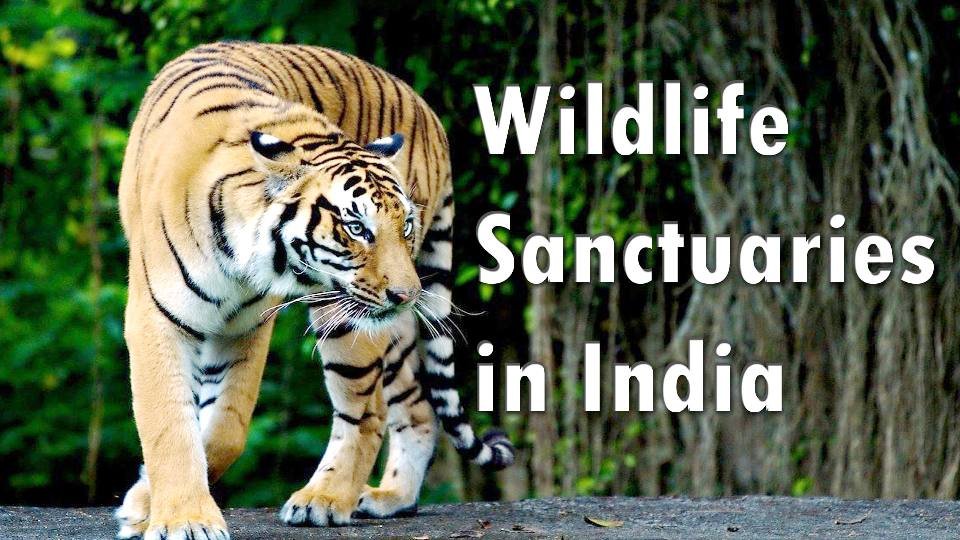Wildlife Sanctuaries in India
A wildlife sanctuary is a protected area where the natural habitats of animals are preserved, and human interference is minimized or prohibited. These sanctuaries serve as safe havens for wildlife, where activities such as hunting, trapping, and poaching are strictly forbidden. The primary goal of wildlife sanctuaries is to provide a secure environment for animals to thrive naturally.
India is home to some of the most breathtaking wildlife sanctuaries, nestled among towering mountains, vast rivers, and dense forests. These sanctuaries are vital for the conservation of India’s rich biodiversity, offering refuge to countless species of flora and fauna.

Legal Framework and Classification
Wildlife sanctuaries in India are classified under the IUCN Category IV, which designates them as protected areas with a focus on the conservation of specific species or habitats. The Wildlife (Protection) Act of 1972 empowers state governments to declare areas as wildlife sanctuaries if they hold significant ecological, geomorphological, or natural value.
Largest Wildlife Sanctuary in India
Ranthambore National Park, located in Rajasthan, holds the title of the largest wildlife sanctuary in India. Known for its population of Bengal tigers, this sanctuary is a prime example of successful wildlife conservation.
Total Number of Wildlife Sanctuaries in India
As of November 2023, India boasts a total of 573 wildlife sanctuaries, covering an area of 123,762.56 square kilometers, which accounts for 3.76% of the country’s total land area. Additionally, there are 218 proposed wildlife sanctuaries that will span an area of 16,829 square kilometers. The Vedanthangal Bird Sanctuary in Tamil Nadu, established in 1796, is the oldest bird sanctuary in India.
List of National Parks in India
| State/Union Territory | National Park Name | Establishment Year |
|---|---|---|
| Andaman & Nicobar Islands | Campbell Bay National Park | 1992 |
| Galathea Bay National Park | 1992 | |
| Mahatma Gandhi Marine (Wandoor) National Park | 1982 | |
| Middle Button Island National Park | 1987 | |
| Mount Harriet National Park | 1987 | |
| North Button Island National Park | 1987 | |
| Rani Jhansi Marine National Park | 1996 | |
| Saddle Peak National Park | 1987 | |
| South Button Island National Park | 1987 | |
| Andhra Pradesh | Papikonda National Park | 2008 |
| Rajiv Gandhi (Rameswaram) National Park | 2005 | |
| Sri Venkateswara National Park | 1989 | |
| Arunachal Pradesh | Mouling National Park | 1986 |
| Namdapha National Park | 1983 | |
| Assam | Dibru-Saikhowa National Park | 1999 |
| Kaziranga National Park | 1974 | |
| Manas National Park | 1990 | |
| Nameri National Park | 1998 | |
| Rajiv Gandhi Orang National Park | 1999 | |
| Bihar | Valmiki National Park | 1989 |
| Chhattisgarh | Guru Ghasidas (Sanjay) National Park | 1981 |
| Indravati (Kutru) National Park | 1982 | |
| Kanger Valley National Park | 1982 | |
| Goa | Mollem National Park | 1992 |
| Gujarat | Vansda National Park | 1979 |
| Blackbuck (Velavadar) National Park | 1976 | |
| Gir National Park | 1975 | |
| Marine (Gulf of Kachchh) National Park | 1982 | |
| Haryana | Kalesar National Park | 2003 |
| Sultanpur National Park | 1989 | |
| Himachal Pradesh | Great Himalayan National Park | 1984 |
| Inderkilla National Park | 2010 | |
| Khirganga National Park | 2010 | |
| Pin Valley National Park | 1987 | |
| Simbalbara National Park | 2010 | |
| Jammu and Kashmir | City Forest (Salim Ali) National Park | 1992 |
| Dachigam National Park | 1981 | |
| Kishtwar National Park | 1981 | |
| Jharkhand | Betla National Park | 1986 |
| Karnataka | Anshi National Park | 1987 |
| Bandipur National Park | 1974 | |
| Bannerghatta National Park | 1974 | |
| Kudremukh National Park | 1987 | |
| Nagarahole (Rajiv Gandhi) National Park | 1988 | |
| Kerala | Anamudi Shola National Park | 2003 |
| Eravikulam National Park | 1978 | |
| Mathikettan Shola National Park | 2003 | |
| Pampadum Shola National Park | 2003 | |
| Periyar National Park | 1982 | |
| Silent Valley National Park | 1984 | |
| Madhya Pradesh | Bandhavgarh National Park | 1968 |
| Fossil National Park | 1983 | |
| Indira Priyadarshini Pench National Park | 1975 | |
| Kanha National Park | 1955 | |
| Madhav National Park | 1959 | |
| Panna National Park | 1981 | |
| Sanjay National Park | 1981 | |
| Satpura National Park | 1981 | |
| Van Vihar National Park | 1979 | |
| Maharashtra | Chandoli National Park | 2004 |
| Gugamal National Park | 1975 | |
| Nawegaon National Park | 1975 | |
| Pench (Jawaharlal Nehru) National Park | 1975 | |
| Sanjay Gandhi (Borivali) National Park | 1983 | |
| Tadoba National Park | 1955 | |
| Manipur | Keibul-Lamjao National Park | 1977 |
| Meghalaya | Balphakram National Park | 1985 |
| Nokrek Ridge National Park | 1986 | |
| Mizoram | Murlen National Park | 1991 |
| Phawngpui Blue Mountain National Park | 1992 | |
| Nagaland | Intanki National Park | 1993 |
| Odisha | Bhitarkanika National Park | 1988 |
| Simlipal National Park | 1980 | |
| Rajasthan | Mukundra Hills National Park | 2006 |
| Desert National Park | 1992 | |
| Keoladeo Ghana National Park | 1981 | |
| Ranthambhore National Park | 1980 | |
| Sariska National Park | 1992 | |
| Sikkim | Khangchendzonga National Park | 1977 |
| Tamil Nadu | Guindy National Park | 1976 |
| Gulf of Mannar Marine National Park | 1980 | |
| Indira Gandhi (Annamalai) National Park | 1989 | |
| Mudumalai National Park | 1990 | |
| Mukurthi National Park | 1990 | |
| Ladakh | Hemis National Park | 1981 |
| Telangana | Kasu Brahmananda Reddy National Park | 1994 |
| Mahavir Harina Vanasthali National Park | 1994 | |
| Mrugavani National Park | 1994 | |
| Tripura | Clouded Leopard National Park | 2007 |
| Bison (Rajbari) National Park | 2007 | |
| Uttar Pradesh | Dudhwa National Park | 1977 |
| Uttarakhand | Corbett National Park | 1936 |
| Gangotri National Park | 1989 | |
| Govind National Park | 1990 | |
| Nanda Devi National Park | 1982 | |
| Rajaji National Park | 1983 | |
| Valley of Flowers National Park | 1982 | |
| West Bengal | Buxa National Park | 1992 |
| Gorumara National Park | 1992 | |
| Jaldapara National Park | 2014 | |
| Neora Valley National Park | 1986 | |
| Singalila National Park | 1986 | |
| Sunderban National Park | 1984 |
List of Wildlife Sanctuaries in India
| S.No. | Name of Wildlife Sanctuary | State |
|---|---|---|
| 1 | Bharatpur Bird Sanctuary | Rajasthan |
| 2 | Chilka Lake Bird Sanctuary | Odisha |
| 3 | Chinnar Wildlife Sanctuary | Kerala |
| 4 | Gir National Park and Wildlife Sanctuary | Gujarat |
| 5 | Govind Wildlife Sanctuary | Uttarakhand |
| 6 | Mudumalai Sanctuary | Tamil Nadu |
| 7 | Periyar Wildlife Sanctuary | Kerala |
Related Information Links:
| Topic | Link |
|---|---|
| Complete History of TATR | Complete History of TATR |
| The History of Lions in India | The History of Lions in India |
| Gir National Park Guide | Gir National Park Guide |
| Explore Tadoba | Explore Tadoba |
| Ultimate Guide to Kanha National Park | Ultimate Guide to Kanha National Park |
| World Wildlife Day | World Wildlife Day |
FAQ on Wildlife Sanctuaries in India
1. What is a wildlife sanctuary?
A wildlife sanctuary is a protected area designated for the conservation of wildlife and their natural habitats. It aims to provide a safe environment where animals can live freely without human interference such as hunting, trapping, or poaching.
2. How are wildlife sanctuaries different from national parks?
While both wildlife sanctuaries and national parks are protected areas, the main difference lies in the level of protection and management. National parks often have stricter regulations and are more regulated in terms of human activities. Wildlife sanctuaries offer protection but may allow certain activities like grazing and collection of non-timber forest products, depending on their specific regulations.
3. What is the purpose of wildlife sanctuaries?
The primary purpose of wildlife sanctuaries is to conserve endangered species and their habitats. They provide a safe haven for wildlife, help maintain ecological balance, and promote biodiversity conservation. Sanctuaries also facilitate scientific research and environmental education.
4. How many wildlife sanctuaries are there in India?
As of November 2023, India has 573 wildlife sanctuaries covering a total area of 123,762.56 km². Additionally, 218 more sanctuaries are proposed, covering an area of 16,829 km².
5. What are some of the largest wildlife sanctuaries in India?
Some of the largest wildlife sanctuaries in India include:
- Ranthambore National Park (Rajasthan)
- Kaziranga National Park (Assam)
- Gir National Park (Gujarat)
- Sundarbans National Park (West Bengal)
6. What is the role of the Wildlife Protection Act of 1972?
The Wildlife Protection Act of 1972 is a significant legislation that governs the protection and conservation of wildlife in India. It empowers state governments to declare specific areas as wildlife sanctuaries and establishes guidelines for the protection of wildlife and their habitats.
7. Can visitors enter wildlife sanctuaries?
Yes, visitors can enter wildlife sanctuaries, but access is usually regulated to prevent disturbance to the wildlife. Visitors often need to obtain permits and follow specific guidelines set by the sanctuary authorities. Safari tours and guided visits are common ways to explore these areas.
8. Are there any wildlife sanctuaries dedicated to specific animals?
Yes, some wildlife sanctuaries are dedicated to the protection of specific species. For example:
- Gir National Park is dedicated to the Asiatic lion.
- Kanha National Park is known for its population of the Bengal tiger.
- Kaziranga National Park is renowned for its one-horned rhinoceros.
9. What activities are prohibited in wildlife sanctuaries?
In wildlife sanctuaries, activities such as hunting, poaching, trapping, and collecting forest products are strictly prohibited. Some sanctuaries also restrict activities like fishing, camping, and picnicking to ensure minimal disturbance to wildlife.
10. How can one contribute to wildlife conservation in sanctuaries?
You can contribute to wildlife conservation by:
- Supporting conservation organizations and initiatives.
- Participating in eco-tourism and wildlife safaris conducted in a responsible manner.
- Volunteering for wildlife conservation projects.
- Raising awareness about the importance of wildlife protection and habitat conservation.
11. What should visitors keep in mind while visiting wildlife sanctuaries?
Visitors should follow the sanctuary guidelines, respect wildlife and their habitats, avoid feeding or disturbing animals, and adhere to designated paths and zones. It’s important to have a responsible and ethical approach to wildlife tourism.
12. How can one find more information about specific wildlife sanctuaries in India?
For more detailed information about specific wildlife sanctuaries, you can visit official websites of the forest departments, wildlife conservation organizations, and reputable travel guides. Additionally, websites like Wildlife Nest offer comprehensive information about various wildlife sanctuaries.


